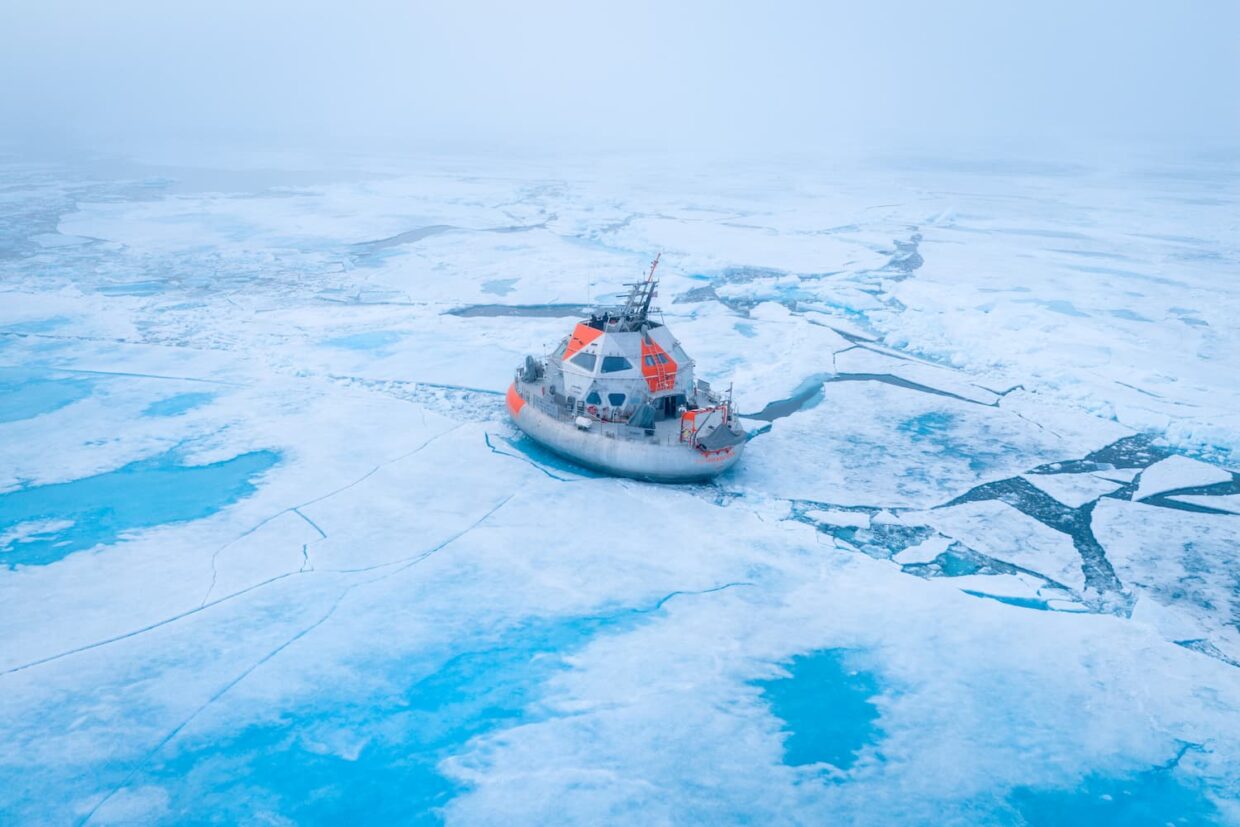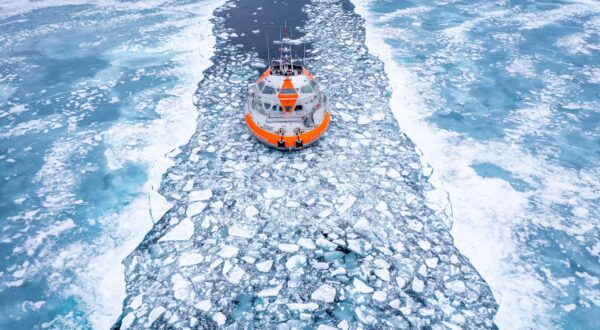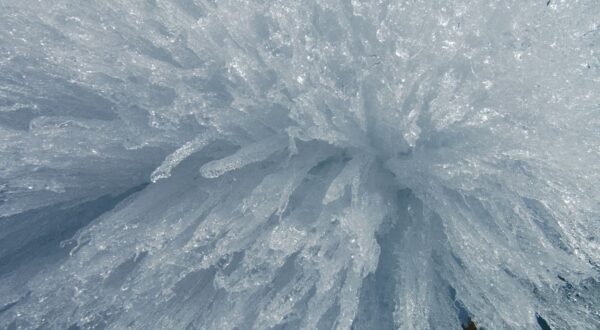Ice Floe: Sentinel of the Poles and key indicator of climate change
Explore the ice pack: how it forms, its crucial role in the climate, the effects of melting ice in the Arctic and Antarctic, and the impact on the polar and global ecosystems.

What is the ice floe?
The ice floe is a layer of sea ice that forms on the ocean surface in polar regions, mainly in the Arctic and Antarctic. Unlike glaciers, which are mostly on continents, the ice floe floats on water.
Different types of ice floes
There are two main types of ice floes:
- Pack ice: floating and drifting ice floe.
- Fast ice: ice floe fixed to the coasts.
The ice floe is part of the cryosphere; all areas where water is present in solid form – snow or ice. This cryosphere covers about 10% of the Earth’s surface.The cryosphere includes:
- The ice caps of Antarctica and Greenland, which alone cover approximately 3% of the Earth’s surface
- The 200,000 glaciers distributed on all continents
- The ice floe
- Snow
- Permafrost, (permanently frozen soil covering nearly a quarter of the land in the Northern Hemisphere)
How does the ice floe form?
The formation of the ice floe takes place in several stages, as soon as the sea water temperature drops below -1.8 °C:
- Slush: ice crystals in suspension.
- Frazil ice: accumulation of crystals under the effect of wind.
- Pancake ice: plates that can measure 3 m in diameter.
- Young ice: 10 to 30 cm thick.
- First-year ice: 30 cm to 2 m thick.
- Multi-year ice: up to 3 m or more.
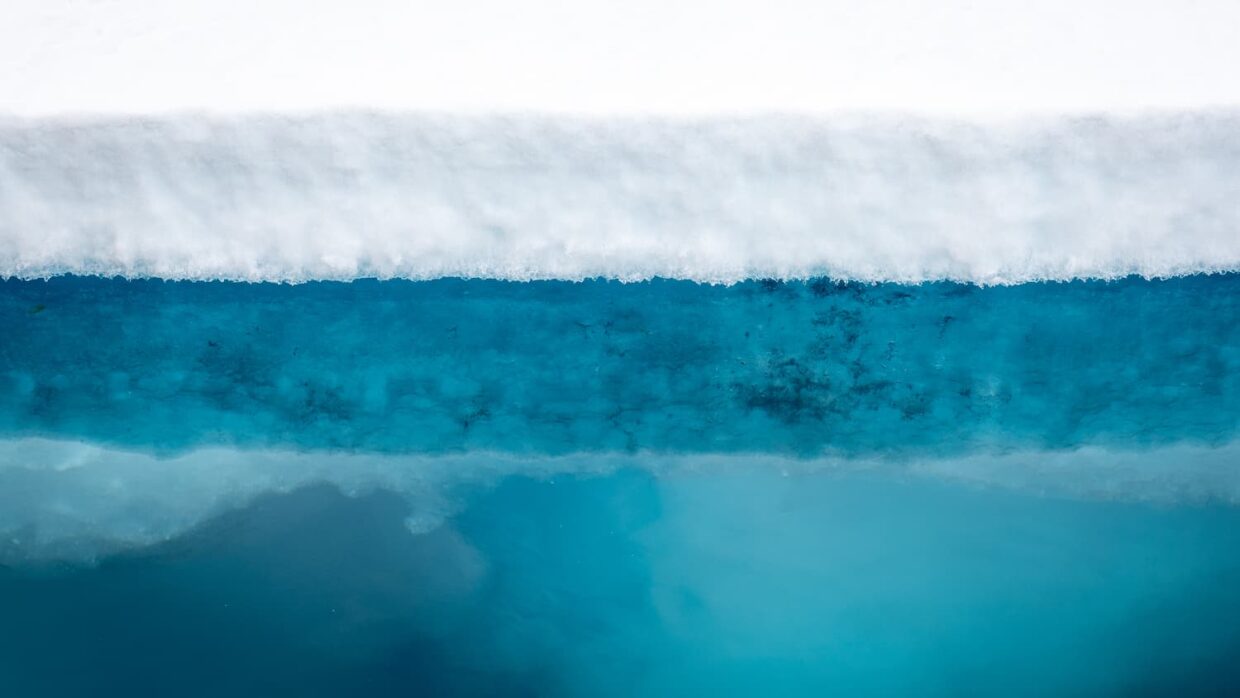
Amazing fact: the ice floe softens over time!
Ice formation is a phenomenon that expels salt. When the seawater temperature reaches -1.8°C, the water freezes without incorporating on average half of the salt crystals, which will cluster into brines and precipitate to the ocean floor. The other half remains trapped in the ice in small pockets. It is during winter, over time, that the salt from these brines migrates by gravity towards the base of the ice floe before gradually rejoining the seawater to dissolve again.
Sea ice in constant movement
The ice floe is dynamic: its movements are influenced by winds and ocean currents. Plates can move away or collide, creating compression ridges.
Fast ice, near the coasts, is influenced by tides and also by the wind; it sometimes moves onto the coast and accumulates there.
Is polar ice seasonal?
Glaciers not really, but the ice floe varies greatly with the seasons:
- In winter, it expands and covers almost the entire Arctic Ocean, approximately 11 million km2.
- In summer, it retreats, reaching its minimum in September in the Arctic and in March in the Antarctic. The increase in temperature in summer first causes the ice thickness to decrease. Thus weakened and subjected to wind, it fractures in a second stage. This alternation is called embacle (formation) and debacle (disappearance).
The increase in temperature due to the greenhouse effect shortens the embacle periods and increases the debacle periods. There are fewer negative degrees globally, so there is less ice formation, and the débâcle periods are longer.
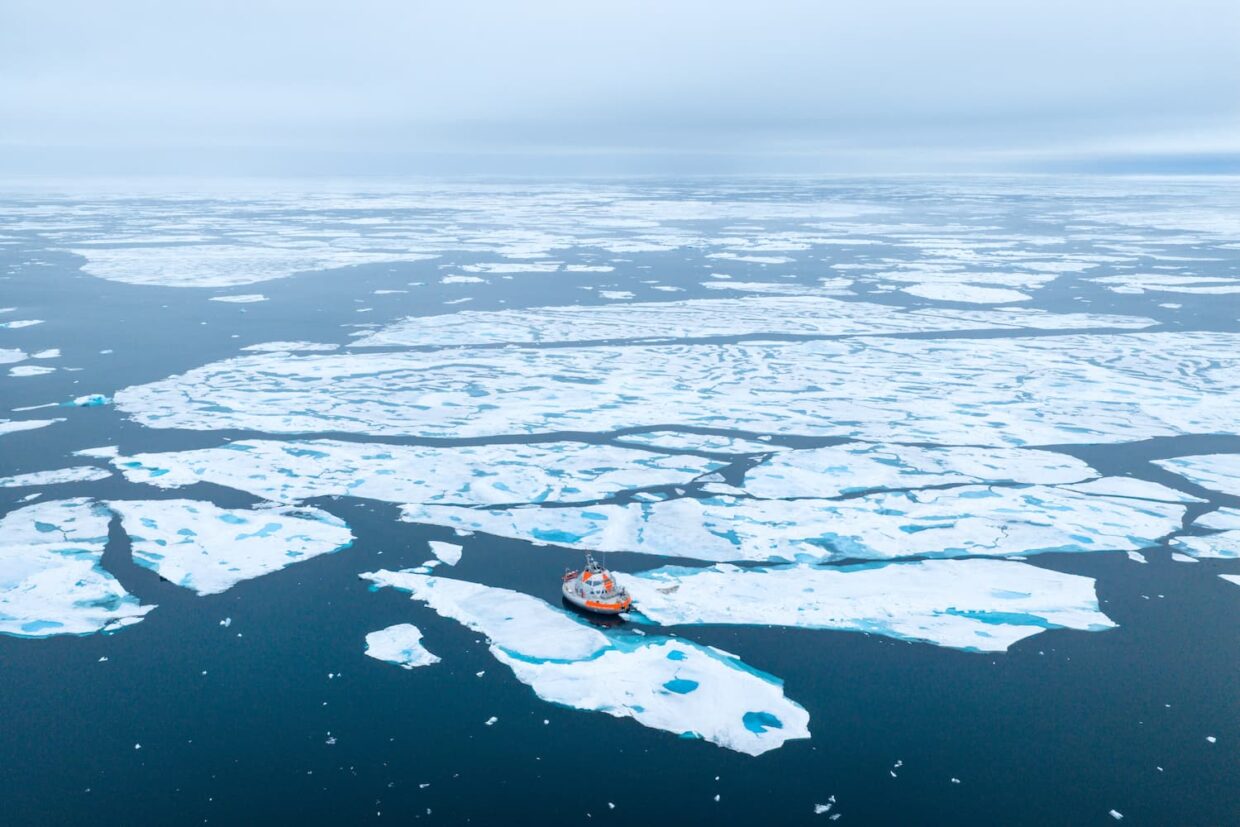
What is the role of the ice floe in climate change?
1. Albedo effect: natural thermal mirror
Thanks to its white color, the ice floe reflects a large part of the solar energy back into the atmosphere. This albedo phenomenon allows 90% of solar radiation to be reflected back into space. When the ice floe melts, it is replaced by the dark ocean, which absorbs this solar radiation, amplifying global warming.
With its gradual decrease, the ice floe becomes more vulnerable to climate variations each year. The darker ocean replaces it and absorbs more solar heat, which amplifies warming. It is therefore likely that the thinning of the ice floe will lead to increased warming of the Arctic Ocean, accelerating its own disappearance.
2. Role in ocean circulation
The salinity of the water under the ice floe increases sharply during the winter. This cold, salty water becomes denser and tends to sink to the ocean depths, thus feeding the deep currents of thermohaline circulation. The latter is responsible for redistributing heat in the different ocean basins.
However, the rapid melting of the ice floe and glaciers with increasing atmospheric temperatures injects freshwater, which is less dense, into the ocean, disrupting these deep ocean currents.
3. No direct impact on sea level
Since it is formed from frozen seawater, its melting does not increase the ocean level (unlike glaciers and ice caps).
4. Natural barrier
The ice floe naturally protects the coasts from erosion caused by waves and storms.
A unique and fragile polar ecosystem
The ice floe constitutes the vital habitat and breeding ground for iconic polar animals. The polar bear, for example, depends directly on the ice floe to hunt seals, its main food source. Seals themselves, as well as walruses, use these ice expanses as platforms to rest, reproduce, and shelter their young from predators. Many species of seabirds also find secure nesting areas and privileged feeding grounds on the ice floe.
The ice floe is the base of the polar food chain. Beneath its surface and sometimes even within the ice itself, an incredible diversity of phytoplankton and ice algae develops. These microscopic organisms, which draw their energy from sunlight, are the first link in life in these icy waters. They are then consumed by krill, small shrimp that teem in polar waters. Krill, in turn, is the essential food for a multitude of species, from fish to whales, as well as seals and seabirds.
The disappearance of the ice floe threatens all polar biodiversity.
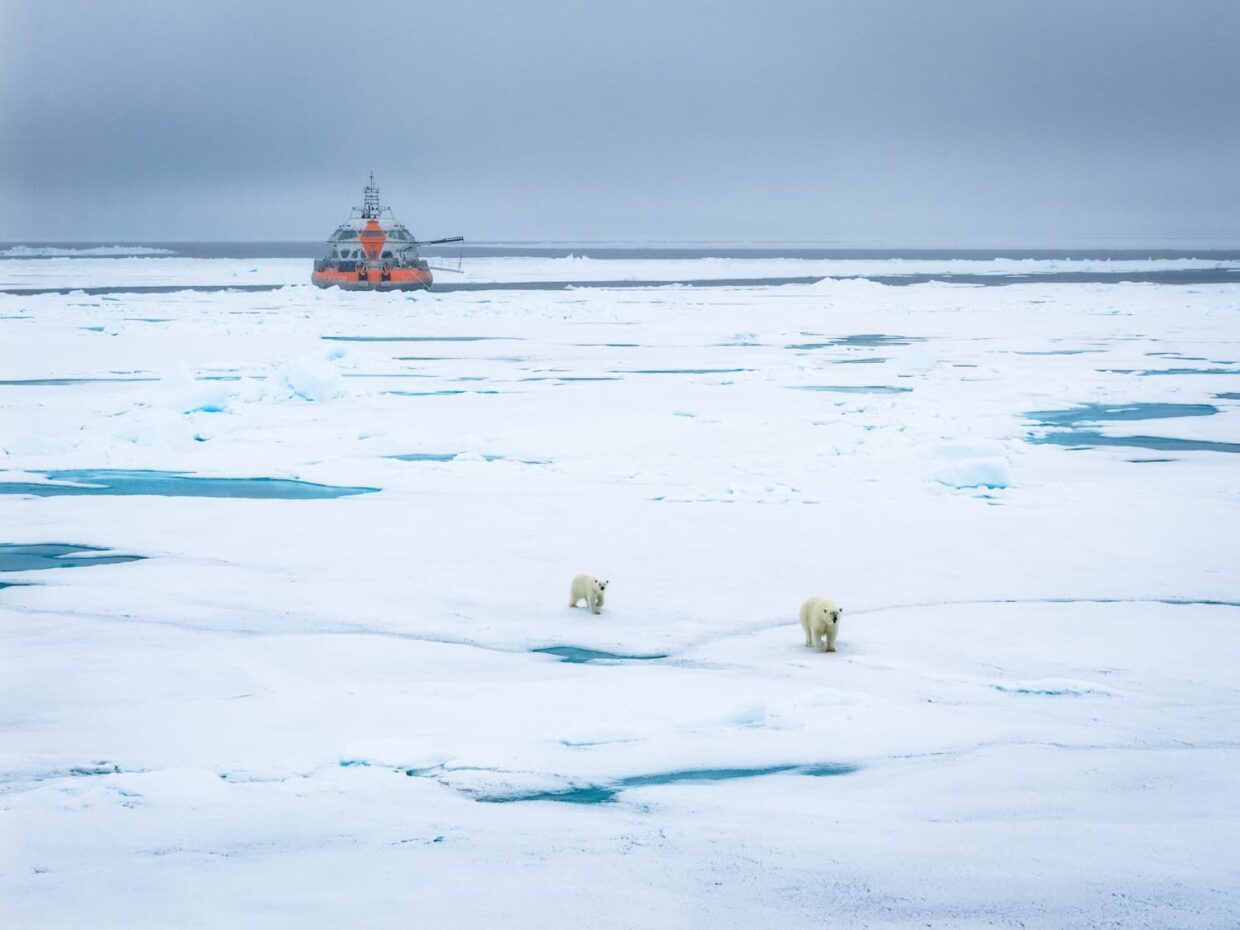
Ice melt and global warming
Why are we talking about accelerated melting?
Over the past forty years, the minimum September Arctic sea ice extent has decreased by approximately 12.8% per decade. These changes have not been observed for at least a thousand years. (IPCC, 2019)
Warm winters like those from 2016 to 2018 showed temperature increases of +6 °C in the Arctic, causing accelerated melting with a dramatic decrease in the frozen sea surface.
Due to these successive seasonal decreases, the portion of the sea ice remaining from one season to the next is becoming smaller, so the average volume of the sea ice is decreasing every year.
What are the effects of this melting?
1. Atmospheric pollution
Human activities, including industry and increased shipping, even from distant areas, can lead to atmospheric pollution in the Arctic.
Fine atmospheric carbon particles, also called “black carbon,” can settle on the ice. These small black specks deposited on the sea ice, seemingly harmless, have the effect of concentrating infrared radiation and accelerating ice melt by penetrating the ice. The surface of the sea ice also melts, particularly in depressions, forming light blue freshwater pools on the ice. This phenomenon, called ‘melt pond,’ in turn contributes to the reduction of albedo.
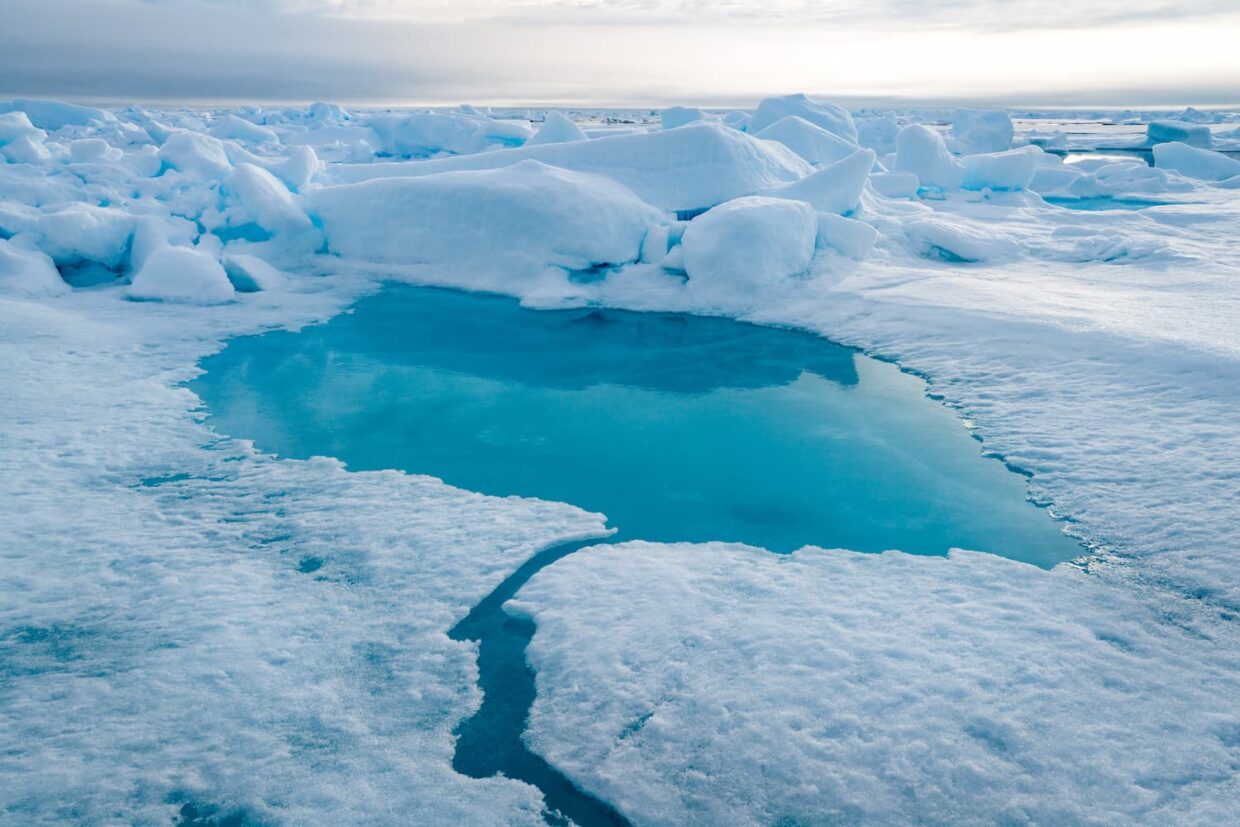
2. Navigation and maritime routes
Although the melting of Arctic ice creates new shipping routes, it also increases navigation risks due to ice instability. Increased traffic amplifies these dangers in an environment where extreme conditions are frequent, thus requiring enhanced safety and rigorous planning.
A Polar Code for the construction and management of new ships came into force in 2017 with multiple new constraints that aim to minimize risks but also increase construction costs by 30% on average.
3. Global disruption of currents and climate
Salinity changes affect thermohaline circulation, with potential effects on the global climate.
Sea ice, glaciers, and ice sheets: what are the differences?
| Criterion | Sea Ice | Glaciers | Ice Sheets |
|---|---|---|---|
| Definition | Sea ice formed by the freezing of seawater | Mass of ice formed on land from the accumulation and compaction of snow. | Vast continental ice mass covering a large area; also called Inlandsis, often several kilometers thick, with different flow dynamics. |
| Formation | By direct freezing of seawater at -1.8°C | By accumulation of snow over centuries/millennia | By accumulation of snow over centuries/millennia |
| Location | Polar Ocean (Arctic, Antarctic) | Mountainous regions, poles, and cold areas | Antarctic Continent and Greenland |
| Support | Floats on water | Rests on continental land | Rests on entire continents |
| Seasonality | Expands in winter and retracts in summer | Evolves slowly, but little visible seasonal variation | Slow evolution over the long term |
| Thickness | From a few centimeters to 3 meters (sometimes up to 5 m for multi-year ice) | From a few tens to several hundreds of meters | Up to several kilometers thick |
| Impact on sea level | No elevation when melting | Yes, if glacier flows into the sea (calving or melt) | Yes, major contribution to sea level rise |
| Associated Biodiversity | Vital habitat for the polar ecosystem (polar bears, seals, ice algae, krill, seabirds) | Less rich, but may contain specific life forms | Little specific biodiversity, but influences surrounding marine currents and ecosystems |
| Climatic Role | Very strong albedo effect (reflects solar radiation), influences ocean currents and ocean temperature | Freshwater storage; slow release of water into rivers and streams | Regulation of sea level and massive storage of freshwater |
| Examples | Arctic Ocean, Weddell Sea and Ross Sea | Mont Blanc Glacier, Perito Moreno Glacier, Himalayan glaciers | Antarctic ice sheet, Greenland ice sheet |
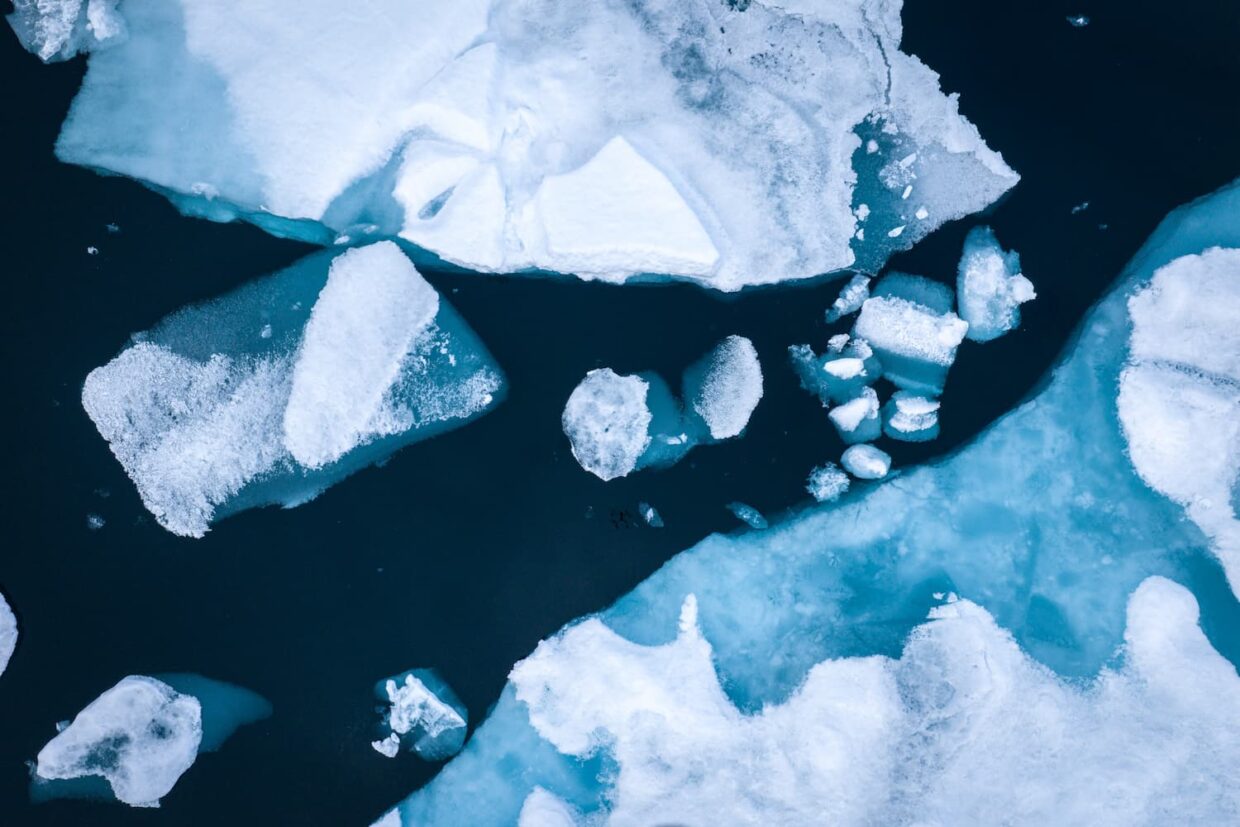
Tara Polar Station, our future is being played out in the Arctic
Until 2045, our scientific research vessel, Tara Polar Station, specially designed to withstand ice, will undertake multiple successive drifts in the Arctic Ocean. It will host scientists from around the world to document and understand the transformation dynamics of this polar ecosystem, question scientific data, and inventory the richness of local biodiversity, while minimizing its impact on the immediate environment.
